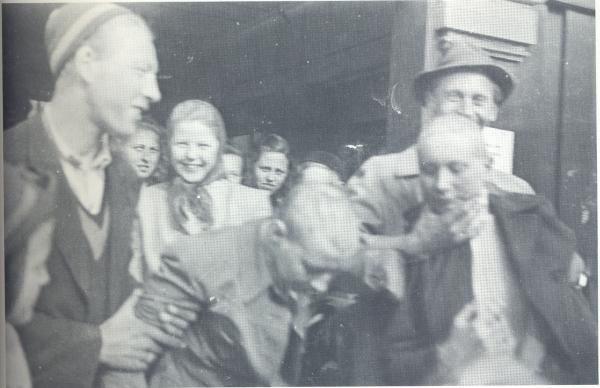
This is what “X” wrote in a letter printed in the newspaper Arbeiderbladet on May 29
– These girls had committed the classic betrayal of sleeping with the enemy. Large groups felt a strong hatred against them and many people expected the girls to be punished, says Terje A. Pedersen, who has written the Master’s thesis Tyskerjentene i Norge. Reaksjoner og klippeaksjoner 1940–46. (Girls involved with German soldiers in
The punishment
“(…) tyskertøsene, these crude, calculating, anti-social individuals who have lived large on the German war studs. (…) Who would be more fitting to clean up the dirt from the “masters” than these women who have slept with them, received money, food, beverages, and cigarettes from them?” (Arbeiderbladet June 27 1945)
The suggestion from this reader was actually implemented some places. The around 100 000 girls who in some way had been involved with a German soldier suffered people’s anger in different ways. The most well-known type of assault was the hair-cutting, where the mob cut the hair off suspected girls, sometimes in public. But even if this has become the symbol of the retribution on these girls, only a small number of girls underwent this punishment, according to Pedersen’s calculations.
– Probably less than five percent of the girls had their hair cut off. We remember this punishment due to its symbolic meaning, a kind of cleansing process, says Pedersen.
The hair-cutting was the revenge of the people. Officially the government washed its hands off it. But they also emphasized that the rage was “understandable”.
– Even when the assailants were brought to court, the verdict emphasized that the court understood how it could happen, says Pedersen.
The revenge of the government

“The women who don’t reject the Germans will pay a terrible price the rest of their lives,” Toralv Øksnevad, also known as “the voice from
– Officially and legally the internment was not a punishment. But there is no doubt that it was part of the revenge. The logs sometimes reveal this: The interned women are referred to as “prisoners” and the camps as “jails” or “prison camps”, says Pedersen.
– When I look at the specific cases it is obvious that the temporary laws were used as an excuse to arrest these girls, says Pedersen. He found very few instances where girls seemed to need protection.
Moral contamination
The fear of contagious diseases was also exaggerated. Only 20 percent of the women who arrived at the National Internment camp for women on Hovedøya had a sexually transmitted disease, although some of them had received treatment before they arrived. In the
– Merely being in a café with Germans could brand a girl as contagious. The fear of diseases sprung from an increase in STDs during the war, but the biggest fear seems to have been the moral contamination from “immoral” women, comments Pedersen.
– The disease control propaganda fitted the fabricated image of girls involved with Germans: That they were prostitutes and morally corrupt women.
It was also commonly assumed that the girls were stupid. Several experts actually supported this notion. Doctor Augusta Rasmussen, for instance, tested the intelligence of 310 women interned on Hovedøya. She concluded that around half of them could be considered backward and only eight had a normal level of intelligence. Chief Executive Ødegård at
– It was also said that the girls were ugly. Basically it was important to portray these girls as the “lowest of the low” among Norwegian women. It probably had to do with male pride and self-esteem: Norwegian men had suffered a military loss. That the Germans also had “taken their women” was another offence. Therefore it became important to point out that these were the kind of girls that Norwegians did not want, Pedersen suggests.
Love
But according to Pedersen, the image of the these girls as stupid, ugly, disease-ridden prostitutes was of great ideological importance in another sense.
Pedersen has gone through readers’ letters, newspaper stories, and various memos from committees and ministries in addition to around 1000 police reports from the internment camp archives. Nowhere is the word “love” to be found.
– Admitting that these relationships merely could be love affairs between normal people would disrupt the black and white image of the Germans and the war. It would have normalized the relationship to
– Hundreds of thousands of young men came to
Translated by Vigdis Isachsen
- Around 100.000 Norwegian women were involved with one or more German soldiers during World War II.
- In the months following the liberation in May 1945 these women were subject to strong reactions from the people and the government.
- Several thousand women were attacked by the mob and had their hair cut off.
- Perhaps as many as 14.000 were interned and locked up by the authorities, some of them for several months.
Terje A. Pedersen: Tyskerjentene i Norge. Reaksjoner og klippeaksjoner 1940–46. (Girls involved with German soldiers in Norway. Reactions and hair-cutting attacks 1940–46). Master’s thesis in history, University of Oslo.
